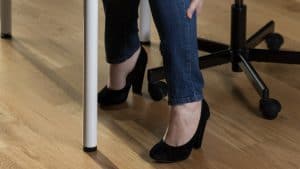Your feet can turn purple for many reasons, but the most common culprit is circulation-related problems. In today’s world, sitting is our neutral state. Most of us have to sit at a desk all day, either at work or school, and it doesn’t stop when we get home. Sitting is what we do to get some rest and do when we get work done. It’s only a matter of time before problems start to arise.
In today’s post, we’ll cover some of the most common reasons that can turn your feet purple and tell you about possible remedies.

Potential Causes
Purple feet can be a symptom of larger problems and shouldn’t be ignored. If your feet are turning purple, be sure to get medical attention at the nearest possible time.
In our post, we’ll be talking about some of the most common causes of blue feet when sitting down, which is an activity that can exasperate any underlying condition that’s related to loss of circulation.
Foot Injuries
One of the most common causes of purple or blue spots on foot is injury. If you see bruising on your foot, check if there’s pain accompanying it. Try to remember if you stubbed or dropped something on your foot in the past few days. Some people might have high pain tolerance and can bruise themselves without realizing it.
If there’s severe pain in your foot and swelling, you should get medical attention as soon as possible. If that’s not the case, the injury may be a shallow bruising on the skin. The discolored skin may feel tender to the touch for a day or two, but it will heal by itself in a few days.
However, if your feet turn purple without bruising, swelling, or pain, the root of the problem might be deeper. Usually, blue or purple skin indicates a lack of oxygenation in the area due to decreased blood flow, also called Acrocyanosis.
Acrocyanosis
Acrocyanosis is the discoloration that happens when the small blood vessels in the skin get constricted, and the area doesn’t get enough oxygen. It may affect the hands as well as the feet. There’s usually no pain.
When the tiny blood vessels on the skin suddenly constrict due to trauma, cold, or emotional distress, the skin may get discolored and turn purple or blue. Acrocyanosis is usually caused by stress, as well as exposure to extreme cold weather. Therefore, if you’re living in a cold area, keeping your hands and feet extra warm may be a solution.
Studies state that acrocyanosis is more common in females than males since women tend to have lower BMI (Body Mass Index) than men. That’s also why acrocyanosis is also more commonly experienced by individuals with anorexia disorder.
Discoloration of the skin that looks similar to acrocyanosis may also be the symptom of a bigger phenomenon called Raynaud’s disease.
Raynaud’s Disease
Raynaud’s disease, also known as Raynaud’s syndrome, is a disease that’s very similar to acrocyanosis. This disease is also caused by exposure to extreme cold weather or excessive stress, and it’s also more commonly seen in women.
Raynaud’s disease usually sets itself apart by causing numbness and a tingling sensation in the purple/blue-ish areas of the foot or hands. These areas, which are usually concentrated around toes and fingers, usually first turn a pale white color in Raynaud’s disease and then turn blue or purple.
There are two types of Raynaud’s disease. The first one, which is called primary Raynaud’s, is a common phenomenon almost identical to acrocyanosis and can be experienced by anyone. The second type, however, which is called secondary Raynaud’s, is a more severe problem that may be caused by a preexisting condition such as:
- Carpal tunnel syndrome,
- Artery diseases,
- Lung problems due to smoking, and
- Connective tissue damage or disease.
If one of these is the reason, your doctor will direct you to a specialist. If there is no underlying condition, your doctor may prescribe calcium channel blockers, which should solve the issue without much hassle.
Ischemic foot
Ischemia means that blood flow is restricted in a specific body parts.
Ischemic foot is usually caused by artery problems such as arterial injuries or blood clots. It can also be due to a condition where plaque builds up inside the arteries and restricts blood flow, which is called atherosclerosis. People with high blood pressure and high blood sugar are also prone to ischemic foot.
Initial symptoms of the ischemic foot are cramping in the feet muscles, cold feet, and toes taking on a blue/purple color. In the most advanced cases, an ischemic foot can cause sores and ulcers; strangely enough, it may feel like the bottom of your feet may hurt along with a burning sensation.
Promoting blood flow is critical for the treatment of the ischemic foot. This means that you can go on walks to increase the circulation in your feet, and you may also want to consider reducing the time you sit down daily. A good solution to this can be using a standing desk as you’re working or studying.
Using a standing desk also has many other health benefits. If you’re curious, you can read our recent post on the benefits of standing desks, where we have talked about these benefits extensively.
In the most severe cases, the ischemic foot may lead to gangrene or the death of the skin tissue, which may require amputation. Some less severe cases that are caused by clogged arteries can also be treated by manually declogging the artery, which is called angioplasty.
Peripheral Artery Disease (PAD)
Peripheral artery disease (PAD) is another condition related to restricted blood flow. It’s caused by the narrowing of the arteries, which reduces the blood circulation in your feet. It is very hard to diagnose in the early stages because earlier symptoms are almost unnoticeable.
Some of the most common symptoms of Peripheral artery disease include:
- Discoloration on the feet (blue/purple skin),
- Numbness in the leg accompanied by weakness,
- Regular painful cramps, which may be on the thigh or hip muscles,
- Skin that appears shiny,
- Loss of hair on the legs, and
- Sores or wounds that don’t heal or heal very slowly.
In addition to these symptoms, some people may develop a condition called claudication, which makes walking painful. In the more progressed cases, you may feel pain in your feet or legs even when sitting or lying still.
It’s important to note that there’s a significant connection between high blood pressure, diabetes, and Peripheral Artery Disease. It’s recommended to live a healthier lifestyle if you’re experiencing the symptoms. A few good ways to treat these symptoms are:
- Changing your diet,
- Quitting smoking, and
- Adopting a more physically-active lifestyle.
Additionally, since this condition may cause a stroke, your doctor may also prescribe medication to balance your blood sugar or pressure. However, an overall lifestyle change is still crucial to treat PAD in the long run.
Conclusion
As you can see, there are a variety of diseases and syndromes that can turn your feet purple. What’s important to remember is that these are caused by bad circulation, or blood flow, in your feet which can be either prevented by leading a healthier lifestyle or protecting your feet from extremely cold weather.
Activities that promote blood flow in your body can be an efficient way to treat purpling feet. Taking walks is recommended, but another way to promote blood flow! If you don’t have the option to get a massage regularly, you can get a massage chair for your home, which are very convenient.
To conclude our post with some advice: If you notice your feet getting purple or blue, it’s best to schedule an appointment with your primary health care provider as soon as possible. The underlying conditions can progress and make the treatment much more complicated.





